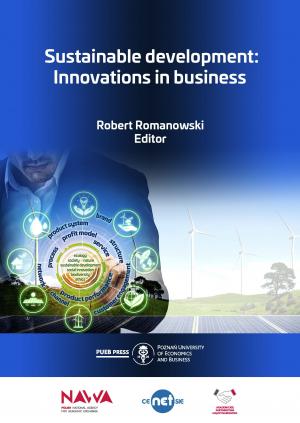Redakcja naukowa
Robert Romanowski
Sustainable development: Innovations in business
Dostępność i zakup
Wersja elektroniczna(IBUK)Wersja elektroniczna
(CEEOL)
*Kliknięcie przycisku powoduje przeniesienie na zewnętrzną platformę udostępniania lub sprzedaży.
Książka jest dostępna w subskrypcjach bibliotecznych: Ibuk Libra i EBSCO.
Romanowski, R. (red.). (2021). Sustainable development: Innovations in business. Wydawnictwo Uniwersytetu Ekonomicznego w Poznaniu. https://doi.org/10.18559/978-83-8211-084-5
Innovation and sustainable development have become buzzwords in the 21st century with the idea of creative destruction launched by Joseph Alois Schumpeter being the base for evolutionary economics. However, new institutional economics helps to understand the necessity of support provided to entrepreneurs and innovators by science and administration to reduce the risk of launching the said innovations. This e-book is devoted to selected types of innovation. Every type of innovation is described with the use of theoretical background and is enriched by adequate case study.
Traditional division into four types of innovation, proposed by J.A. Schumpeter (1934), containing product, process, organizational and marketing innovations, was widely accepted, including European Union institutions (OECD/Eurostat, 2008).
The concept of innovation has long been dominated by a technical approach to the innovation process, despite the economic arguments exposed by one of the precursors of the theory of innovation and, at the same time, the school of evolutionary economics—Joseph Alois Schumpeter. Frequently, in the context of innovation, it is indicated that organizational and marketing aspects play a part in the successful introduction of innovation onto the market.
The structure of the book is based on the typology proposed by Keeley, Walters, Pikkel and Quinn (2013), which focuses on the economic character of innovations. Ten types of innovation are directly related to Schumpeter’s and Oslo Manual classification. A new set of innovations emphasize the economic side of innovation process. The technical novelties are to support new configuration, offering or customers’ experience. This new approach is based on presumptions coming from design thinking idea, leading to user—driven innovation and on cooperation with institutions and entities supporting innovation process.
The chapters are devoted to every type of innovation, grouped into three major parts: innovations based on configuration, offering and experience. In the book, configuration includes types of innovations focused on innermost workings of an enterprise and its business system. Offering part contains the types of innovations, that are focused on an enterprise’s core product (good or service), or a collection of its products. The last part, dedicated to innovations based on experience, is focused on more customer-facing elements of an enterprise and its business system.
PREFACE
Robert Romanowski, Magdalena Wieja
1. BUSINESS MODEL AS AN INNOVATION
1.1. Introduction
1.2. Theoretical background
1.3. Business models in gaming industry
1.4. Implementing business models in gaming industry—the case of The Witcher series by CD Projekt Red
Robert Romanowski, Jakub Jasiczak
2. NETWORK AS AN INNOVATION: SOCIAL INNOVATION—THE CASE OF THE HOSPITAL HELP INITIATIVE DURING COVID-19 PANDEMIC
2.1. Introduction
2.2. Entities and their relationships in the networks
2.3. Process of social innovation
2.4. Case study: the hospital help initiative (WsparcieDlaSzpitala.pl)
2.4.1. The emergence of a pandemic and the problem of uncoordinated help
2.4.2. Dynamic development of the IT system thanks to the cooperation and… luck
2.4.3. The role of the Relationship Team in a successful technology adoption
2.4.4. The way of cooperation with the media in promoting social innovation
2.4.5. Scaling from WsparcieDlaSzpitala.pl in Poland to Helpmed.in.ua in Ukraine
Iskra Panteleeva
3. STRUCTURE AS AN INNOVATION
3.1. Introduction
3.2. Innovation, organization, organizational structures—basic definition aspects
3.3. Types of organizational structures
3.3.1. Classic organizational structures
3.3.2. Typical contemporary organizational structures
3.3.3. Organizational structures of the future
3.4. Case study of M+S Hydraulic Plc.—Kazanlak, Bulgaria
3.4.1. History of the company
3.4.2. Results and solutions of structural innovation
3.5. Case study of PIM-Ltd.—Haskovo, Bulgaria
3.5.1. History of the company
3.5.2. Results and solutions of structural innovation
Lyubcho Varamezov, Iskra Panteleeva
4. PROCESS AS AN INNOVATION
4.1. Introduction
4.2. Theoretical background
4.3. Process innovations—definition aspects, parameters, types and examples
4.4. Factors affecting process innovations
4.5. Case study of Tomika-Metal JSCo—Bulgaria
4.5.1. History of the company
4.5.2. Results and solutions of innovative process
Pavel Kotyza, Luboš Smutka
5. SUSTAINABLE AGRICULTURE: DEVELOPMENT OF ORGANIC FARMING. CASE STUDY OF THE CZECH REPUBLIC
5.1. Organic farming and agricultural sustainability
5.2. Organic farming development in the Czech Republic
5.3. Case study—Organic farm in Milinov, Czech Republic
5.4. Final remarks
Lucie Sara Zavodna
6. SERVICE AS AN INNOVATION
6.1. Introduction
6.2. Theoretical background
6.3. Case study of Whirlpool Czech Republic
6.3.1. Whirlpool: Results and solutions
6.4. Case study of Knihobot (Eng. Book-robot)
Dora Naletina, Mate Damić
7. INNOVATIONS ON RAIL FREIGHT MARKET
7.1. Introduction
7.2. Literature review
7.3. Analysis of Croatian rail freight market
7.3.1. Characteristics of rail freight in the Republic of Croatia
7.3.2. Case study on the example of the Croatian national rail freight operator
Jan Zavodny Pospisil
8. BRAND AS AN INNOVATION—THE CASE OF CZECH WINE
8.1. Introduction
8.2. Theoretical background
8.3. Case study
8.4. Results and solutions
8.5. Conclusion
Iwona Olejnik
9. STORYTELLING IN BUSINESS—HOW TO INCREASE CUSTOMER ENGAGEMENT?
9.1. Introduction
9.2. Storytelling—how to use it?
9.3. Case studies
9.3.1. Join the medical imaging project at Future Processing, and help us create the Better Future—storytelling in employer branding
9.3.2. How has Zelmer brand made the dream of a 4-year-old and an old lady come true?—storytelling and customer engagement
Rozdziały:

Metadane
- ISBN: 978-83-8211-084-5
- DOI: 10.18559/978-83-8211-084-5
- Wydanie: I
- Rok wydania: 2021
- Rok premiery: 2021
- Strony: 136
- Wersja papierowa:
- Wersja elektroniczna: pdf
- Format: B5
- Licencja: open access
business, enterprise, innovations, sustainability, sustainable development
ostatni tydzień: 16
ostatnie 3 miesiące: 281
ogółem: 2507



 Pełna wersja do pobrania (pdf)
Pełna wersja do pobrania (pdf)